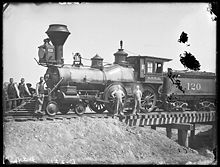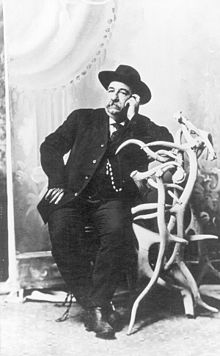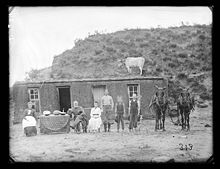Solomon D. Butcher
Solomon Devoe Butcher (born January 24, 1856 in Burton, Virginia , now West Virginia , † March 18, 1927 in Greeley , Colorado ) was an American photographer whose photographic work in the period from 1886 to 1912 included more than 3,000 photographs documented the gradual settlement of the state of Nebraska in the homesteading era .
Life
Solomon D. Butcher was born on January 24, 1856, the first son of Esther and Thomas Jefferson Butcher. His birthplace, Burton, still belonged to Virginia at that time. Only in the Civil War the West Virginia area was awarded. In 1860 he moved with his family to Winona , Illinois , where his father had a job with the railroad. There Solomon D. Butcher graduated from the local high school and first came into contact with photography as an apprentice to a ferrotypist . First he attended military school in Henry , Illinois for a year in 1875 and began to work as a traveling salesman for a company in Clyde , Ohio in 1876 . After his father quit his job with the railroad, Solomon Butcher moved with his brother, brother-in-law, and father to Custer County , Nebraska, to secure land under the Homestead Act. However, Solomon Butcher himself was unable to settle and cultivate the land for the required five or more years before it passed into his possession. Rather, he moved to Minnesota after just two weeks , where he met his first wife, the nurse Lillie Hamilton, while studying medicine at Minnesota Medical College . They married on May 16, 1882.
photography

Back in Custer County, Butcher managed to save enough money to buy photography equipment by working as a teacher. He opened his first studio together with AW Darling in Walworth, a place that shortly afterwards no longer existed, but the family moved to West Union after the birth of their two children, Lynn (* 1883) and Madge (* 1884), where Butcher's studio lasted five years.
1886-1901
In 1886, when the Burlington and Missouri River Railroad connected large parts of Nebraska to the rail network, Solomon D. Butcher decided that he wanted to capture this era of conquest in photographs. He used his father's horse-drawn cart to haul heavy equipment across Custer County. He requested accommodation with the settlers whom he photographed and financed this project with donations and the sale of the pictures he produced. In this way, more than 1,500 photographs were taken over the next seven years, most of which showed individual families in front of their homes and the harsh rural life in the period of settling in Nebraska. In addition, he collected short biographies of the individual settlers, which gave the collection a personal character despite its size. However, a severe drought in the 1890s halted the flow of money and forced Butcher to suspend his project in 1892. In a fire in his house on May 12, 1899, a large part of his photographs and the associated notes were finally destroyed, but the glass plate negatives were saved. With funding from the wealthy rancher Ephraim Swain Finch , Butcher published his planned chronicle in 1901 - fifteen years after the start of his project - under the name Pioneer History of Custer County and Short Sketches of Early Life in Nebraska . The edition of 1,000 pieces turned out to be too small. At a retail price of US $ 2.50 , the second edition of 1,000 copies was sold out that same year.
1901-1912
In the following, Solomon D. Butcher decided to expand his sphere of activity and also documented life in Buffalo , Cherry and Dawson Counties . For financial reasons, he refrained from the detailed documentation of the biographical background of his motives, as before in Custer County. In 1902 he opened a studio in Kearney and began to take photos in other US states such as Utah and Wyoming . In 1904 his second book, Sod Houses of the Great American Plains, was published . In 1912, when the Nebraska land grab was considered complete, Butcher stopped working as a photographer, especially since his equipment and the glass plate negatives he had collected were too heavy to be transported. In 1913 he sold his collection of around 3,500 images to the Nebraska State Historical Society (NSHS) for $ 1,000 .
Late years and death
In 1916, when Butcher was married to his second wife Laura, the NSHS hired him to document and annotate his photographs. Since most of the biographical data had been destroyed in the fire in his house in 1899, he had to rely mainly on memory. This led to some errors in the annotations due to the extensive database and the large time gap. Later they were partially corrected with the help of family members and descendants of the settlers photographed at the time. The archive is still being maintained. Butcher died in Greeley, Colorado after several more unsuccessful attempts to gain a foothold financially. His collection describes the settlement in Nebraska in the second half of the 19th century like no other. On the one hand, the images convey a pioneering feeling, such as the arrival of the first locomotive in Broken Bow. On the other hand, the mostly barren landscape and poor farmers also demonstrate the hardship that life in the Great Plains brought with it.
literature
- John Carter: Solomon D. Butcher: Photographing the American Dream , 1985, University of Nebraska Press, Lincoln, Nebraska, ISBN 0-8032-1404-9
- M. Melissa Wolfe: 'Proving up' on a Claim in Custer County, Nebraska: Identity, Power, and History in the Solomon D. Butcher Photographic Archive (1886-1892) , 2005, dissertation at Ohio State University
Individual evidence
- ↑ cf. Grave inscription ( page no longer available , search in web archives ) Info: The link was automatically marked as defective. Please check the link according to the instructions and then remove this notice.
- ↑ more than 1,500 exhibit of his photographs preserved by the present so-called Sod Houses ( sod houses )
Web links
- Library of Congress website. The search term "Solomon D. Butcher" gives access to over 3,000 digital photographs
- Nebraska Historic Buildings Survey. Custer County , 2006, Nebraska Historical State Society (PDF; 8.2 MB)
- M. Melissa Wolfe: 'Proving up' on a Claim in Custer County, Nebraska: Identity, Power, and History in the Solomon D. Butcher Photographic Archive (1886-1892) , 2005, dissertation at Ohio State University
| personal data | |
|---|---|
| SURNAME | Butcher, Solomon D. |
| ALTERNATIVE NAMES | Butcher, Solomon Devoe (full name) |
| BRIEF DESCRIPTION | American photographer |
| DATE OF BIRTH | January 24, 1856 |
| PLACE OF BIRTH | Burton, Virginia , present-day West Virginia |
| DATE OF DEATH | March 18, 1927 |
| Place of death | Greeley , Colorado |


